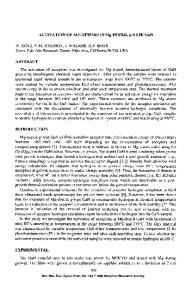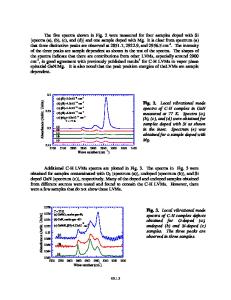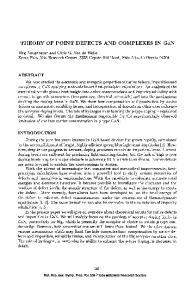Hydrogen, Acceptors, and H-Acceptor Complexes in GaN
- PDF / 449,299 Bytes
- 6 Pages / 414.72 x 648 pts Page_size
- 46 Downloads / 283 Views
exception is negatively-charged H (H-), which sits in the cation-antibonding (ABIII) site. In the BC configuration, H sits at the center of the bond between anion and cation, while in the ABv it sits behind the anion site at a distance close to half bond length; the AB111 is behind the cation at about the same distance as in ABv. In the case of wurtzite, all the above sites have two non-equivalent orientations (axial and planar). Our results are summarized as follows. H is a negative-U center. The effective Hubbard's U is site-dependent, and ranges from about 0 to -1.2 eV. In undoped GaN, incorporation of H should not take place in atomic form in an H2 atmosphere, but becomes possible under p or n-type conditions in an atomic-H-rich environment. The acceptor with the lowest formation energy is Be, which also exhibits a shallow thermal impurity level (E0 1- , 0.1 eV). Mg is relatively shallow (E 0 /- -,, 0.2 eV), while C is deeper (E 0 /- ,- 0.4 eV). The use of Be seems a practicable way to improve doping efficiency in GaN. The formation of neutral H+/X- complexes is found to be exothermic. Again, the antibonding and bond center sites compete as equilibrium geometries. Acceptor efficiency will be low due to H passivation, but the concurrent incorporation of hydrogen and acceptors will be much more favorable than that of H alone. In the case of the H-Mg complex, we calculate the vibrational frequencies of H. None of our frequencies are in even rough agreement with experiment [3]: this discrepancy suggest that the observed frequencies is not due to H-Mg vibrational modes, and other possibilities should be investigated. 503 Mat. Res. Soc. Symp. Proc. Vol. 395 0 1 9 96 Materials Research Society
In the following text and Tables, all energies are expressed in eV, and distances in atomic units. All formation energies listed include relaxation contributions. METHOD Ab-initio calculations have been performed within local density functional theory [4]. A plane-wave basis at constant energy cutoff of 25 Ry, ab-initio ultrasoft pseudopotentials (USPP) [5], and the Monkhorst-Pack [6] (222) special-point mesh for Brillouin zone integration are used. USPP ensure high transferability and require a much lower cutoff than conventional norm-conserving potentials; this is of importance in our case, since the Ga 3d electrons are treated explicitly [7]. Also, localized valence states such as those of Be, N, and Zn, and semicore states as in Ca and Mg, have been easily treated. A conjugate-gradient total-energy minimization has been employed in most cases; for part of the calculations, we used a parallelized iterative diagonalization codes [8]. Hellmann-Feynman forces and a modified Broyden minimization method are used to perform structural optimization for acceptors, hydrogen, and their complexes. For acceptors, we started from the ideal substitutional sites (C on N, and Be, Zn, Ca, and Mg on Ga) in wurtzite supercells of up to 32 atoms. Hydrogen has been studied at some selected sites (BC, ABv, AB 111 , and a few others found to be i
Data Loading...










